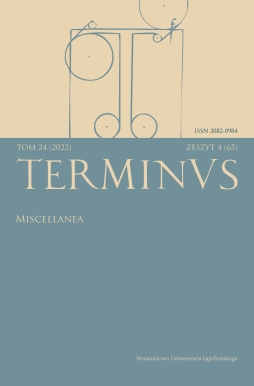Pośrednia recepcja Pindara, czyli Jakuba Vitelliusa epinikion dla króla Władysława IV
Indirect Reception of Pindar: Jakub Vitellius’ Epinicion for King Ladislaus IV of Poland
Author(s): Zofia GłombiowskaSubject(s): Polish Literature, Other Language Literature
Published by: Wydawnictwo Uniwersytetu Jagiellońskiego
Keywords: Pindar; epinicion; Jan Kochanowski; Jakub Vitellius; imitation; stylistic differences;
Summary/Abstract: The paper discusses the only known example of imitating Jan Kochanowski’s poetry written in Latin. The piece is a coronation encomium dedicated to King Ladislaus IV of Poland, entitled Epinicion in celeberrima inauguratione Serenissimi et Invictissimi Domini D[omini] Vladislai IV Regis Poloniae etc., Sueciae Hereditarii etc., electi Ducis Moschoviae (Cracow 1633), by Jakub Vitellius, a professor at Cracow University. The source of the imitation is Jan Kochanowski’s Epinicion (Ad Stephanum Bathorrheum, Regem Poloniae inclytum, Moscho debellato et Livonia recuperata Epinicion. Anno a Christo nato MDLXXXII, Cracow 1583). Modelling his work on Pindar’s epinicia, which are choral odes heralding Olympic victories, Kochanowski created a song celebrating the triumph of King Stephen Bathory over Muscovite Russia.Vitellius reproduced the versification pattern of The 9th Nemean Ode from the 1560 Stephanus edition, i.e. the characteristic 12-verse stanzas and the composition of Kochanowski’s Epinicion; he however changed the order of the two major parts of the work in the interest of historical accuracy. He was also clearly inspired by Kochanowski’s similes, he took over some motifs and even copied some phrasings directly. On the other hand, Vitellius’ convoluted style abounding in synonyms, explications, epithets, complex adjectives, metaphors, periphrases, and extended similes does not resemble Kochanowski’s noble simplicity. Additionally, Vitellius tends to use rhetorical questions and exclamations to express his emotions and does not even hesitate to deploy offensive terms to refer to Poland’s Swedish, Turkish or Muscovite enemies. It is impossible to ascertain whether the striking difference in style between Kochanowski and Vitellius results from the influence of Baroque trends, or from Vitellius’ idea of Pindar’s style which he acquired from Horace’s Ode IV 2, or perhaps from his own reading of Pindar’s odes.
Journal: TERMINUS
- Issue Year: 24/2022
- Issue No: 4 (65)
- Page Range: 385-407
- Page Count: 23
- Language: Polish

